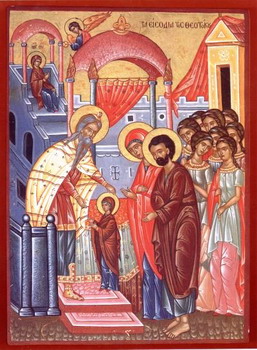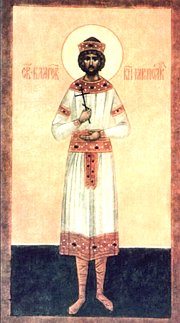|
|
+++ The Entry into the Temple of the Most Holy Mother of God When the most holy Virgin Mary had reached the age of three, her parents, holy Joachim and Anna, took her from Nazareth to Jerusalem, to give her to the service of God in fulfillment of their promise. It was three days journey to Jerusalem, but, going as they were on God"s work, they did not find the journey difficult. Many of Joachim and Anna"s kinsmen gathered to take part in this celebration, in which the invisible angels of God also took part. Maidens went ahead with lighted candles in their hands, followed by the most holy Virgin, led on either side by her father and mother. The Virgin was clad in royal and beautiful garments, like those of the "king"s daughter", the Bride of God (Ps. 44:9,10). Behind them walked many of their kinsfolk and friends, all bearing lighted candles. There were fifteen steps leading to the Temple. Her parents stood the Virgin on the first step, and she ran quickly to the top on her own, where the High Priest, Zacharias, the father of St John the Forerunner, met her and, taking her by the hand, led her not only into the Temple but into the Holy of Holies, the holiest place of all, into which none could enter except the High Priest, and that once a year. St Theophylact of Ochrid says that Zacharias was ,out of himself, and moved by God" when he led the Virgin into the chief place in the Temple, beyond the second curtain - otherwise there could be no explanation of his action. Her parents then offered sacrifices to God, according to the Law, received the priest"s blessing and returned home, leaving the most holy Virgin in the Temple. She dwelt in the Temple for nine whole years. While her parents were alive, they visited her often. When they departed this life, the holy Virgin was left an orphan, and longed to remain in the Temple for the rest of her days, without entering into marriage. This being contrary both to the Law and Israelite custom, she was confided at the age of twelve to St Joseph, a kinsman of hers in Nazareth, so that she might, under the protection of betrothal, live in virginity and thus fulfil both her desire and the demands of the Law, for it was unknown in Israel at that time for a girl to vow perpetual virginity. The holy Virgin Mary was the first to do this, and was later followed by thousand upon thousand of virgin men and women in the Church of Christ. When the most holy Virgin Mary had reached the age of three, her parents, holy Joachim and Anna, took her from Nazareth to Jerusalem, to give her to the service of God in fulfillment of their promise. It was three days journey to Jerusalem, but, going as they were on God"s work, they did not find the journey difficult. Many of Joachim and Anna"s kinsmen gathered to take part in this celebration, in which the invisible angels of God also took part. Maidens went ahead with lighted candles in their hands, followed by the most holy Virgin, led on either side by her father and mother. The Virgin was clad in royal and beautiful garments, like those of the "king"s daughter", the Bride of God (Ps. 44:9,10). Behind them walked many of their kinsfolk and friends, all bearing lighted candles. There were fifteen steps leading to the Temple. Her parents stood the Virgin on the first step, and she ran quickly to the top on her own, where the High Priest, Zacharias, the father of St John the Forerunner, met her and, taking her by the hand, led her not only into the Temple but into the Holy of Holies, the holiest place of all, into which none could enter except the High Priest, and that once a year. St Theophylact of Ochrid says that Zacharias was ,out of himself, and moved by God" when he led the Virgin into the chief place in the Temple, beyond the second curtain - otherwise there could be no explanation of his action. Her parents then offered sacrifices to God, according to the Law, received the priest"s blessing and returned home, leaving the most holy Virgin in the Temple. She dwelt in the Temple for nine whole years. While her parents were alive, they visited her often. When they departed this life, the holy Virgin was left an orphan, and longed to remain in the Temple for the rest of her days, without entering into marriage. This being contrary both to the Law and Israelite custom, she was confided at the age of twelve to St Joseph, a kinsman of hers in Nazareth, so that she might, under the protection of betrothal, live in virginity and thus fulfil both her desire and the demands of the Law, for it was unknown in Israel at that time for a girl to vow perpetual virginity. The holy Virgin Mary was the first to do this, and was later followed by thousand upon thousand of virgin men and women in the Church of Christ.St. Yaropolk-Peter, prince of Vladimir in Volhynia (1086) Holy Nobleborn Prince Yaropolk Izyaslavich, in Holy Baptism Peter, was the grandson of Yaroslav the Wise, and great-grandson of holy Equal-to-the-Apostles Vladimir. He shared the sad fate of his father, the Kievan Greatprince Izyaslav, expelled by his brothers from Kiev. Yaropolk journeyed on various missions for his father to the Polish king, the German emperor, and the Roman Bishop Saint Gregory VII (1073-1085)... Holy Nobleborn Prince Yaropolk Izyaslavich, in Holy Baptism Peter, was the grandson of Yaroslav the Wise, and great-grandson of holy Equal-to-the-Apostles Vladimir. He shared the sad fate of his father, the Kievan Greatprince Izyaslav, expelled by his brothers from Kiev. Yaropolk journeyed on various missions for his father to the Polish king, the German emperor, and the Roman Bishop Saint Gregory VII (1073-1085)... |